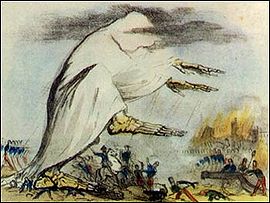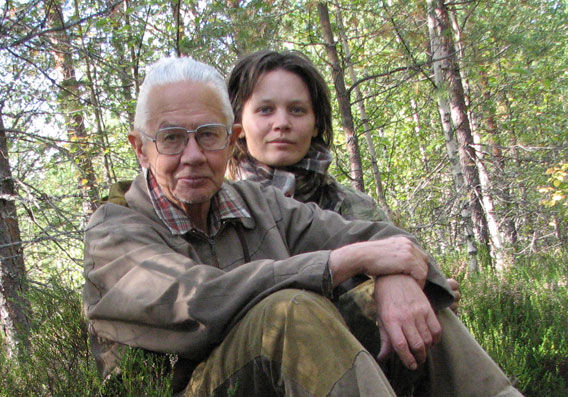Miasma Theory of Disease
(Bad Air)
Greenhouse Gases Theory of Climate Change
(Bad Air)
No wonder so many Europeans believed during the West's medieval eras that world's end was nigh.
If you think it got much better in the Renaissance, it wasn't until the late 1880s that many in the medical and scientific establishments in the West conceded that the miasma theory of disease was a crock. This, despite the fact that the germ theory of disease had been floated in Europe as early as 1546 by one Girolamo Fracastoro, an Italian physician.
But no sooner had Westerners finished fanning themselves in relief that they weren't going to be done in by an invisible airborne threat, along came one Svante Arrhenius, a Swedish physicist more or less turned chemist:
In developing a theory to explain the ice ages, Arrhenius, in 1896, was the first to use basic principles of physical chemistry to calculate estimates of the extent to which increases in atmospheric carbon dioxide (CO2) will increase Earth's surface temperature through a greenhouse effect. These calculations led him to conclude that human-caused CO2 emissions, from fossil-fuel burning and other combustion processes, were large enough to cause global warming.So if you believe Al Gore was the first to warn about greenhouse gases -- oh no; the greenhouse gases theory had been kicking around decades before Svante Arrhenius put his stamp of genius on it:
The existence of the greenhouse effect was argued for by Joseph Fourier in 1824. The argument and the evidence were further strengthened by Claude Pouillet in 1827 and 1838 and reasoned from experimental observations by John Tyndall in 1859, who measured the radiative properties of specific greenhouse gases.
The effect was more fully quantified by Svante Arrhenius in 1896, who made the first quantitative prediction of global warming due to a hypothetical doubling of atmospheric carbon dioxide.
However, the term "greenhouse" was not used to refer to this effect by any of these scientists; the term was first used in this way by Nils Gustaf Ekholm in 1901.
As the Wikipedia article about Arrhenius goes on to note, his conclusion "has been extensively tested, winning a place at the core of modern climate science."
But interest in a greenhouse effect arose not long after the Miasma Theory started coming under fire in medicine -- although it was then decades before miasma was finally tossed in the ashcan of history. There were holdouts right to the bitter end:
A transitional period began in the late 1850s with the work of Louis Pasteur. This work was later extended by Robert Koch in the 1880s. By the end of the 1880s the miasma theory was struggling to compete with the germ theory of disease.Miasma Theory hung on because while it was completely nuts it was also beautiful. It was a simple explanation for epidemics and why physicians couldn't cure people who got sick during epidemics. As to why not everyone got sick when the miasma wafted into their region -- details. It was also very useful outside the profession of medicine:
[In 1840s Britain] No one knew the real causes of disease — the existence and effects of bacteria weren’t even suspected — but many medical theorists doubted the miasma theory, and few would have agreed that malnutrition and poverty were not causes of ill health. Nevertheless [Edwin] Chadwick, a relentless self-promoter who had the ear of those in power, drowned out contrary views, and his opinion became official doctrine.
As medical historian Margaret Pelling writes, “that the correlation between smell and disease became an article of popular faith was a triumph of sanitary propaganda.”
A simplistic miasma theory had the particular advantage for the political and economic elite, in that it excluded fundamental social problems as causes of working class discontent and unrest. It also countered commerce-disrupting calls for quarantines, because if disease was caused by bad air, then the victims weren’t contagious.So while an English surgeon named William Budd managed in the late 1840s to persuade city fathers that Bristol's cholera epidemics would be stopped by cleaning up the city's drinking water, two colleagues making his same arguments were quashed by Miasma Theory diehards.
In short, the germ theory wasn't an overnight success. But as the Miasma star fell, a new star started its ascension in the firmament of science, and it was fully as beautiful and simple as Miasma Theory. In fact it was the Miasma Theory reworked to explain that certain gases as much controlled climate.
So when an American scientist, Charles David Keeling, assembled data showing that carbon dioxide levels were steadily rising, American scientists and the government they served were off and running:
In the early 1960s, the National Science Foundation stopped supporting his research, calling the outcome "routine". Despite this lack of interest, the Foundation used Keeling's research in its warning in 1963 of rapidly increasing amounts of heat-trapping gases. A 1965 report from President Johnson's Science Advisory Committee similarly warned of the dangers of extra heat-trapping gases, which cause the temperature of the Earth to rise.And as with Miasma Theory, extra greenhouse gases came to explain just about everything bad that was happening to the human race and for added emphasis, every perceived bad for the Earth -- that last something the Miasmists didn't claim, perhaps out of fear of raising the Church's ire.
"Just about everything" is barely an exaggeration. This autumn The Guardian announced "the unseen driver" behind the Honduran Migrant Caravan was climate change.
And so, after little more than a century, we've gone from the first Swedish Nobel Laureate, Svante August Arrhenius
To Alexandria Ocasio-Cortez, the youngest member of the U.S. Congress (New York's 14th congressional district), who will be U.S. President as soon as her fans nationwide are old enough to vote for her
Which is to say we've gone from Arrhenius' explanation in 1908 " ... that the human emission of CO2 would be strong enough to prevent the world from entering a new ice age, and that a warmer earth would be needed to feed the rapidly increasing population."
To Ocasio-Cortez' explanation in 2018 that a new system of governance centered around combating global warming will usher in “economic, social, and racial justice.”
Reality Rears its Complicated Head
... modern climate modeling has been traditionally implemented by people with a technological background and little knowledge of ecosystem functioning. Such knowledge is generally poor, too. Thus, the ecological systems are “fed” into the models as a set of geophysical parameters, e.g., albedo, evaporation rate, surface roughness, amount of stored carbon etc.
While the numeric values of these parameters are borrowed from reality, they do not represent the ecosystem functioning in very much the same manner as a colored high-resolution digital photo of a corpse does not represent a live human being.
Without studying the principles of highly-organized functioning of ecological communities, including their genetically encoded ability to respond to environmental perturbations in a non-random compensatory way, the perspectives drawn from global circulation models with respect to the climatic effects of land cover change (e.g., statements like cutting all boreal forests will ease global warming) will continue to lack any resemblance to reality.No they're not ecologists. They're physicist/mathematicians. Russian physicist/mathematicians. The math part means it's taking most American climate scientists a long time to figure out what Victor Gorshkov and Anastassia Makarieva are talking about when they argue that condensation from forests, not temperature differences, drives the winds that cause the rains to fall over land.
Quantitative analysis of ecological and biological variables is a very complicated task due to the complexity of living objects. ... Have a nice day.*
Thereby challenging the accepted model of how Earth's climate works.
To be continued.
* I couldn't resist adding that last sentence.
**********



No comments:
Post a Comment